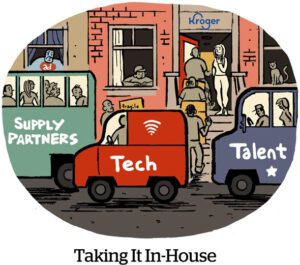Here’s today’s AdExchanger.com news round-up… Want it by email? Sign up here.
Is Free Social A ZIRP?
Social media is free. Well, it’s supposed to be, anyway. That’s the point. All your friends join, it’s free fun, and rather than paying money you get served with ads.
But that could change.
On Monday, Android Authority discovered TikTok code indicating plans to launch an ad-free, $4.99 monthly subscription.
TikTok confirmed that it’s testing an ad-free option in a non-US English-language market (so … England, Canada or Australia), but says it may never launch worldwide.
Best bet is England, where TikTok often tests potential global releases, like its shopping marketplace. A subscription model also makes more sense in Europe and the UK, where stricter data privacy laws make social businesses less profitable.
The Wall Street Journal reports that Meta will charge almost $17 per month for ad-free Facebook and Instagram in the EU. Otherwise, users can agree to personalized ads or take a hike – although that plan might falter. Meta recently agreed to start asking for tracking consent in Europe to comply with GDPR, meaning that people who don’t opt in will essentially be getting a free version minus the personalized ads. Good deal.
But there’s another option for Meta: It’s not impossible the company just gives up and defects from the EU – eventually.
CTV’s Incentive Program
Netflix will raise ad-free prices around the world once the Hollywood actors’ strike is over, The Wall Street Journal reports.
The connection to Hollywood contracts is increasingly important as studios build new inducements into their production deals. For example, studios are incentivized to push advertising – at the expense of subscription revenue.
Neither writers nor actors get a cut of streaming advertising. They share licensing and subscription fees, which is the cable TV model. The result is that studios keep ad revenue while subscription revenues are sliced and diced away.
Historically, Netflix has been precious with its subscribers. It had no desire to strong-arm password sharers or subscribers in any way.
But now, Netflix wants to push viewers from ad-free tiers to advertising. The price of Netflix’s ad-supported subscription is less than half what the ad-free tier costs, a low number it splits with Hollywood workers as it makes up the rest – and more – with ads.
Exclusive benefits for ad-free subscribers are also disappearing. Ad-supported viewers will get access to a full archive or be able to download movies and episodes for offline viewing.
Terms Of The Debate
Advertisers want to remove made-for-advertising (MFA) inventory from their campaigns. But first the industry needs to define what it is, exactly.
The ANA alongside the 4A’s and other industry groups took a crack at defining MFA last week. But critics say the workshopped definition falls short of a proper standard, Digiday reports.
The new definition cites five criteria for MFA sites: ads occupy more than 30% of desktop space, rapidly auto-refreshing ads, reliance on paid traffic, syndicated content and template-based web design.
According to the ANA, made-for-advertising sites don’t have to check all five boxes to qualify. Meeting at least three of the five criteria could be enough, says EVP Bill Duggan. The 4A’s EVP of Media Ashwini Karandikar says the definition is a starting point for the sell side to create guidance around what constitutes “good media.”
But DoubleVerify Chief Product Officer Jack Smith argues that programmatic needs workable standards, not a starting point for deliberation.
Still, while the definition of MFA may be open to interpretation, emerging guidelines should at least help lead to more consistency in terms of which sites tend to get labeled as MFA by different groups, says Jounce Media’s Chris Kane.
But Wait, There’s More!
Spotify’s CEO is urging the UK to enact tougher regulation against tech gatekeepers. [Financial Times]
Traffic referrals from Facebook and Twitter to top news publishers have collapsed since 2021. [Axios]
Another bad sign for social media’s relationship with news: Campbell Brown, who headed Meta’s news partnerships team, is leaving the company. [Axios]
LinkedIn has a new AI assistant to help brands use its ad platform. [Ad Age]
Meta is (already) looking for ways to revive interest in Threads. [The Information]
You’re Hired!
Netflix promotes Amy Reinhard to president of advertising as Jeremi Gorman prepares to leave the company. [Adweek]
Havas Media Network names Joy Allen-Altimare as CRO for North America. [Campaign]
Martina Suess Cromer has been named global chief communications officer at the IPG agency FCB. [Adweek]


















